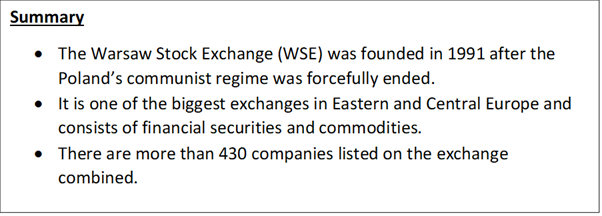What do you mean by Warsaw Stock Exchange?
The Warsaw Stock Exchange (WSE) is the most extensive stock trade in Central and Eastern Europe and perhaps the most perceived monetary establishment in Poland. It runs financial and commodities markets to exchange instruments, for example, organisation shares, securities, subsidiaries, and spot and forward agreements for power and natural gas.

Copyright © 2021 Kalkine Media
Understanding WSE
Capital markets in Poland date to 1817, when the Warsaw Mercantile Exchange was established. In 1991, the state depository made the Warsaw Stock Exchange a business entity following the defeat of Poland's socialist system in 1989. The WSE was set up as a cutting-edge stock trade with electronic exchanging and dematerialised enrollment of securities.
Exchanging started on April 16, 1991. Five once state-claimed ventures were indexed: Tonsil, Próchnik, Krosno, Kable, and Exbud. As of April 2021, the WSE indexed 432 organisations on its primary and equal business sectors, generally addressing 1.1 trillion PLN in market capitalisation.
The WSE is the most significant trade in Central and Eastern Europe. It works for two principal organisations: a money market and a product's market. The monetary market exchanges values, subordinates, and securities. The product Market exchanges spot and forward agreements for power and flammable gas, notwithstanding fossil fuel by-product remittances. Commodities exchanging contributes about 40% of total revenue.
Numerous financial specialists expect that Eastern Europe will remain a space of fast development, and the WSE will profit with the expanded speculation. The WSE's expressed mission is to provide regulated trade and clearing administrations, support financial growth, and guarantee exclusive requirements and security of exchanging practices.
The WSE works Monday through Friday, with most equity sessions beginning at 9 am and finishing at 4.50 pm. Subordinates items begin exchanging at 8.45 am. In contrast, other speculation itsems start at 9.05 am.
The WSE is a business entity established by the State Treasury. The Treasury holds a 35% offer in the capital. The accompanying instruments are exchanged on the WSE: shares, bonds, membership rights, allocations, and subsidiaries like futures, options, and index participation units.
Since its origin, the WSE has been occupied with electronic exchanging. The WAR SET exchanging stage has been being used from November 2000 to April 2013; it has been supplanted by the UTP stage, given the NYSE Euronext stage some time ago having a similar name. An extra market called NewConnect was presented on August 30, 2007.
The most significant power of the WSE is the General Meeting of Shareholders of the WSE. All Stock Exchange investors reserve the privilege to partake in the regular gathering.
The Exchange Supervisory Board administers the exercises of the Exchange. It comprises 5 to 7 individuals. The Exchange Supervisory Board meets essentially once a quarter. The term of office of its individuals is joint and endures three years.
The Exchange Management Board deals with the everyday tasks of the Exchange, concedes protections to trade exchanging, characterises the guidelines for acquainting protections with exchanging, directs the exercises of trade merchants and trade individuals in the field of trade exchanging. The work of the Management Board is overseen by the President of the Management Board named by the General Meeting. At present, the leader of the WSE is Marek Dietl.
There are 15 indices on the WSE, which are as follows:
- WIG: WIG, initially an abbreviation for Warszawski Indeks Gie?dowy (Warsaw Stock Exchange Index), is the most seasoned index of the Warsaw Stock Exchange, presented on the WSE's first exchanging meeting on April 16, 1991.
- WIG20: The WIG20 is a capitalisation-weighted securities exchange index of the twenty most prominent organisations on the Warsaw Stock Exchange. WIG is an abbreviation for "Warszawski Indeks Gie?dowy," which means Warsaw Stock Index in Polish.
- WIG30: The WIG30 is a capitalisation-weighted financial exchange index of the thirty most prominent organisations on the WSE. The WIG30 index has been distributed since September 23, 2013, given the worth of the arrangement of portions of the 30 most prominent and most fluid organisations on the WSE Main Market.
- mWIG40
- sWIG80
Sectoral Indices
- WIG BANKI
- WIG BUDOW
- WIG CHEMIA
- WIG DEWEL
- WIG ENERG
- WIG INFO
- WIG MEDIA
- WIG PALIWAL
- WIG PL
- WIG SPOZYW
- WIG SUROWCE
- WIG TELKOM
The WSE in 2009, the RESPECT Index in Central and Eastern Europe's first index of socially capable organizations. It covers organizations from Poland and throughout the planet indexed on the WSE Main Market, which observe the best expectations in corporate administration and divulgence while likewise considering natural and social principles.
Organizations in the index are screened by the WSE and the Association of Listed Companies (SEG) in a three-venture survey of these variables and are examined by the undertaking accomplice.
Frequently Asked Questions
What is the history of the Warsaw Stock Exchange?
Another law was passed in 1921 and afterward in 1926 and 1935 individually to control the stock trade. The Polish trades got subject to the world emergencies of 1929. Nonetheless, they recuperated in the second half of the 1930s. From there on, in 1939, Poland was involved by Russian and German powers. Subsequently, the entirety of the Polish stock trades was shut. In 1989, after the fall of the socialist system, the re-foundation of the WSE occurred.
During this time, France offered monetary guide and experience. In the current structure, the WSE began its exercises on April 16, 1991. On the primary day of exchanging, only five stocks were indexed. While seven businesses took part in the exchange, there are very nearly 112 purchase and sell orders. Since then, this stock trade is developing and growing quickly and presently is concerned with the European market. In September 2008, FTSE perceived this stock trade as an advanced emerging one alongside nations like Taiwan and South Korea.
 Please wait processing your request...
Please wait processing your request...